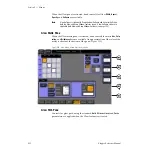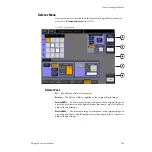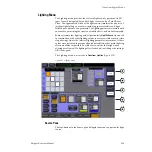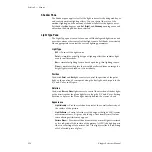
Kalypso Reference Manual
335
M/E Menus
Hue Modulation
(
) operates like Color Modulation, but instead of
mixing between two color mattes, the modulating signal maps incoming
luminance to matte hue. As the instantaneous luminance value of the
incoming video changes from black to white, the instantaneous hue of the
processed picture changes in hue angle. As the luminance increases, the
hue value increases toward magenta, red, etc., counterclockwise on the vec-
torscope.
The direction of the lookup table is reversed by pressing the
Invert
button.
When Invert is active, increasing luminance decreases the hue angle, clock-
wise toward cyan and green.
The
Hue Offset
control sets the hue angle derived from a black input. A Hue
Offset of zero means that black would produce a matte with hue angle of
zero, or approximately dark blue. As the Hue Offset is increased, the hue
angle for a black input also increases. The range for the Hue Offset control
is 0 to 359 degrees, and it wraps at 360 degrees and 0. The hue angle derived
from a white input is approximately 180 degrees from that for the black
input.
The
Saturation
control can be adjusted from 0 to 100%. 100% means the
chroma levels are the same as 100% SMPTE bars. 0% means black and
white. The luminance values pass through the Hue Modulation processor
unaffected.
The
Modulation Gain
and
Modulation Clip
operate similar to standard Clip and
Gain controls. Modulation Gain affects how far the hue will shift with a
black to white luminance change. Modulation Clip and Hue Offset interact
to control the starting and ending hues (black and white hues).
















































